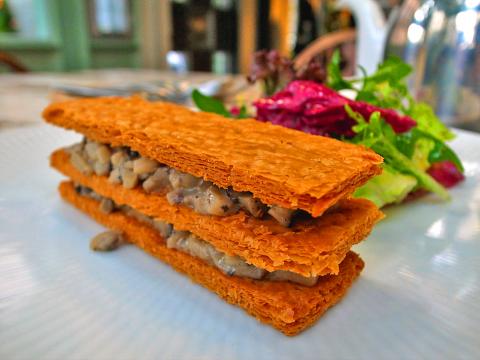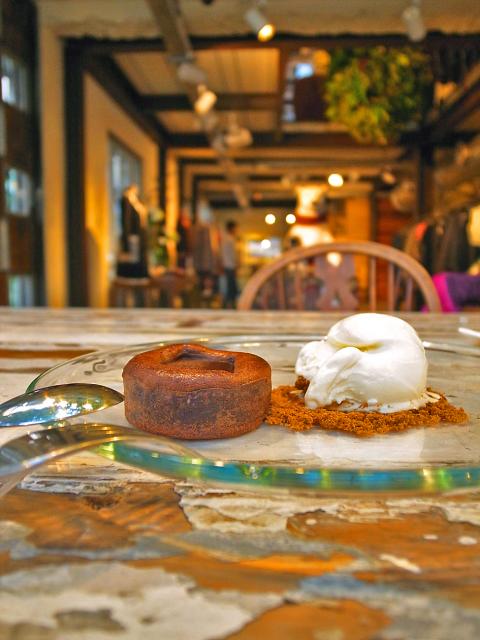Fashion and food are the two things that are done in style at One Fifteen, a boutique store and cafe located in the heart of Taipei, near the intersection of Da-an Road (大安路) and Zhongxiao East Road (忠孝東路). Envisioned as a platform to showcase young, creative Taiwanese designers, the establishment goes one step further to flatter visitors with a design-savvy tearoom that serves up light meals crafted by a chef with cooking experience at Michelin-starred restaurants.
It is almost impossible to walk in the fashionable neighborhood without noticing the two-story establishment surrounded by lush plants. Inside the charming cafe, an open kitchen reveals neatly attired cooks working their magic with the Le Creuset cookware in bright, vibrant colors. What makes the space immediately appealing is that it feels and looks like a greenhouse, bathed in natural light that floods in from a skylight and several floor-to-ceiling windows. Wood elements dominate the interior, which is punctuated with fresh flower bouquets, potted plants and quaint ceiling lamps decorated with white lace. This world apart from the urban hubbub outside seats no more than 18 diners at a time.
One Fifteen features a selection of salads, sandwiches, desserts and other light refreshments, from a menu created by Anne Lan (蘭惟涵), the chef from L‘Orchidee (山蘭居), a French restaurant tucked away in Wuchih Mountain (五指山) near Neihu (內湖). The ingredients are said to be mostly organic, and the cooking style tends towards the Mediterranean.

Photo: Ho Yi, Taipei Times
During a visit on a recent Sunday, my dining partner and I were both pleasantly surprised by the cafe’s signature truffle Napoleon layered tart with mixed greens (NT$320). Layered with mushrooms and truffle, the savory mille-feuille was delicately flavored and not overly rich. The grilled chicken and artichoke pesto on an open-faced ciabatta (NT$320) was good, but didn’t wow us as we’d hoped. The egg en cocotte, which consisted of a poached egg with bacon in a cute, tiny Le Creuset pot, was actually the highlight of the dish.
Other popular dishes include the salad composed of grilled steak, fresh seasonal greens and shallot vinaigrette (NT$420) and the crab toast (NT$1,500 for two persons), a decadent combination of choice crab meat, caviar and specially concocted mayonnaise that needs to be ordered three days in advance.
For drinks, the menu features a highly recommended selection of freshly squeezed juice (NT$230 and NT$250). There is also a collection of gourmet teas (NT$220 and NT$240) ranging from the celebrated products of Mariage Freres to organic German teas.

Photo: Ho Yi, Taipei Times
The cafe includes a limited but appealing list of desserts, fruit tarts and pastries. Chocoholics will get a solid fix with the brownie and vanilla ice cream (NT$180). Other items to indulge your sweet tooth include the French toast with mixed berries and vanilla ice cream (NT$280).
If you really want to splurge, wander over to the adjacent boutique. It carries 13 indie designer labels mostly from Taiwan, but also from other countries, such as Japan and the UK. The store focuses on cutting-edge, young designers who experiment creatively with colors and prints or construct silhouettes and shapes. Sure enough, being a fashion-forward shopper is a costly prospect at One Fifteen. Prepare to fork out NT$50,000 for a dress, or NT$15,000 for a sweater.
For those who don’t want to spend a month’s salary on clothing, One Fifteen remains a relaxing spot to chill with friends after a fruitful day of shopping elsewhere in the city’s bustling fashion district. Dining time is limited to 90 minutes due to the cafe’s small capacity, with a minimum charge of NT$350.

Photo: Ho Yi, Taipei Times

President William Lai (賴清德) has championed Taiwan as an “AI Island” — an artificial intelligence (AI) hub powering the global tech economy. But without major shifts in talent, funding and strategic direction, this vision risks becoming a static fortress: indispensable, yet immobile and vulnerable. It’s time to reframe Taiwan’s ambition. Time to move from a resource-rich AI island to an AI Armada. Why change metaphors? Because choosing the right metaphor shapes both understanding and strategy. The “AI Island” frames our national ambition as a static fortress that, while valuable, is still vulnerable and reactive. Shifting our metaphor to an “AI Armada”

When Taiwan was battered by storms this summer, the only crumb of comfort I could take was knowing that some advice I’d drafted several weeks earlier had been correct. Regarding the Southern Cross-Island Highway (南橫公路), a spectacular high-elevation route connecting Taiwan’s southwest with the country’s southeast, I’d written: “The precarious existence of this road cannot be overstated; those hoping to drive or ride all the way across should have a backup plan.” As this article was going to press, the middle section of the highway, between Meishankou (梅山口) in Kaohsiung and Siangyang (向陽) in Taitung County, was still closed to outsiders

The older you get, and the more obsessed with your health, the more it feels as if life comes down to numbers: how many more years you can expect; your lean body mass; your percentage of visceral fat; how dense your bones are; how many kilos you can squat; how long you can deadhang; how often you still do it; your levels of LDL and HDL cholesterol; your resting heart rate; your overnight blood oxygen level; how quickly you can run; how many steps you do in a day; how many hours you sleep; how fast you are shrinking; how

“‘Medicine and civilization’ were two of the main themes that the Japanese colonial government repeatedly used to persuade Taiwanese to accept colonization,” wrote academic Liu Shi-yung (劉士永) in a chapter on public health under the Japanese. The new government led by Goto Shimpei viewed Taiwan and the Taiwanese as unsanitary, sources of infection and disease, in need of a civilized hand. Taiwan’s location in the tropics was emphasized, making it an exotic site distant from Japan, requiring the introduction of modern ideas of governance and disease control. The Japanese made great progress in battling disease. Malaria was reduced. Dengue was